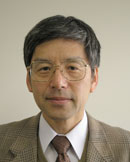CREST PhaseII
Mitsuyoshi Ueda Team

- Mitsuyoshi Ueda
- Professor, Kyoto University
Focused biotechnologies suitable for complete utilization of marine macroalgae
For "bioproduction of fuels and useful compounds" as resourses of abundant marine macroalgae, we will find out useful enzymes degrading cell wall components of marine macroalgae from metagenome libraries and genomic information of cellulose-utilizing microorganisms. Demonstration of their functions of identified genes by cell surface engineering and construction of high functional and expert whole-cell biocatalysts will be carried out. By our focused biotechnologies, production of biofuels, fuel cells, and useful compounds from marine macroalgae will be challenged. Finally, we will construct fundamental and focused biotechnologies and realize "Biorefinery establishment" of marine macroalgae.
Hiroyuki Ohta Team

- Hiroyuki Ohta
- Professor, Tokyo Institute of Technology
Strategic Construction of Algal Lipid Production System Utilizing Plant Vegetative Organs as a Model
Algae generally do not have organs to accumulate storage compounds such as lipids and carbohydrates. They rather accumulate these storage compounds specifically when suffering from some stress such as nutrient starvation. We recently found that plant vegetative organs including leaves and roots also accumulate these storage lipids under nutrient shortage conditions. In this project, we strategically construct systems to produce very large amount of lipids in algal cells utilizing plant vegetative organs as a model. To perform this, we will primarily establish a research platform for several useful algae, which covers overall information of genome, transcriptome and lipid metabolome, and subsequently construct algal systems to accumulate large amount of lipids useful for chemical materials and biofuels.
Tatsuo Omata Team

- Tatsuo Omata
- Professor, Nagoya University
Development of an efficient system for free fatty acid production using cyanobacterial mutants affected in nitrate assimilation.
We aim at increasing the efficiency of free fatty acid production by cyanobacteria. To reduce the cost of fertilizers and to increase the light use efficiency, we develop a method to regulate cell growth by nitrogen limitation during the production and excretion of free fatty acid. Our goal is to achieve a ten-times higher level of fatty acid production per unit of cellular nitrogen than the present level, which would correspond to production of four-times greater mass of the product than that of the cell dry matter.
Toru Hisabori Team

- Toru Hisabori
- Professor, Tokyo Institute of Technology
Research on the efficient biosynthesis of nitrogenous substances using artificially optimized nitrogen fixing cyanobacteria
Nitrogen fixing cyanobacteria synthesize nitrogenous substances such as amino acids in the cell using atmospheric nitrogen gas as a major material. On this process they first produce ammonia and use them for the biosynthesis of amino acids. Our research goal is the establishment of the new technology to produce nitrogenous substances using nitrogen fixing cyanobacteria. For the purpose we will optimize the metabolic pathway of the bacteria for the production and invent the new technology to obtain objective compounds from the cell culture.
Shinya Miyagishima Team

- Shinya Miyagishima
- Associate Professor, Research Organization of Information and Systems, National Institute of Genetics
Creation of heat and acid tolerant algae toward high biomass production
Red algae are one of the major groups of eukaryotic algae in aquatic biomass. We have determined the complete genomic sequence of the red alga Cyanidioschyzon merolae which represents major biomass in acidic hot spring. In addition, we have developed procedures for genetic modification of this alga. In this project, we will chracaterize mechanisms of carbon fixation and carbohydrate production in extreme conditions to create heat and acid tolerant algae for high biomass production by genetical modification.

